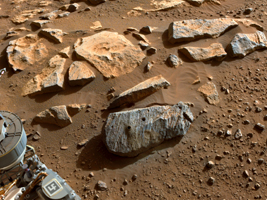
Figure 1This image taken by NASA's Perseverance rover on Sept. 7, 2021, PDT (Sept. 8, EDT), shows two holes where the rover's drill obtained chalk-size samples from rock nicknamed "Rochette." The hole on the left side is known as "Montagnac" (drilled on Sept. 7), and the hole on the right is known as "Montdenier" (drilled on Sept. 1). A round spot where the rover abraded part of the rock's surface, nicknamed "Bellegarde," is visible under the hole on the right. Tailings (or cuttings) from the Montdenier coring activity slid over Bellegarde.
This main image in which a rover wheel is visible was taken by one of Perseverance's Hazard Avoidance Cameras. A second image (Figure 1) was taken by a Navigation Camera from a higher vantage point on the rover's mast. Both were taken on the 196th sol (Martian day) of the rover's mission and processed to enhance contrast.
A key objective for Perseverance's mission on Mars is astrobiology, including the search for signs of ancient microbial life. The rover will characterize the planet's geology and past climate, pave the way for human exploration of the Red Planet, and be the first mission to collect and cache Martian rock and regolith (broken rock and dust).
The Mars 2020 Perseverance mission is part of NASA's Moon to Mars exploration approach, which includes Artemis missions to the Moon that will help prepare for human exploration of the Red Planet.
Subsequent NASA missions, in cooperation with ESA (European Space Agency), would send spacecraft to Mars to collect these sealed samples from the surface and return them to Earth for in-depth analysis.
NASA's Jet Propulsion Laboratory in Southern California built and manages operations of the Mars 2020 Perseverance rover for NASA.
For more information about the mission, go to: https://mars.nasa.gov/mars2020

